Mr. Garrison’s Final SDSU Aztec Grades – Part II
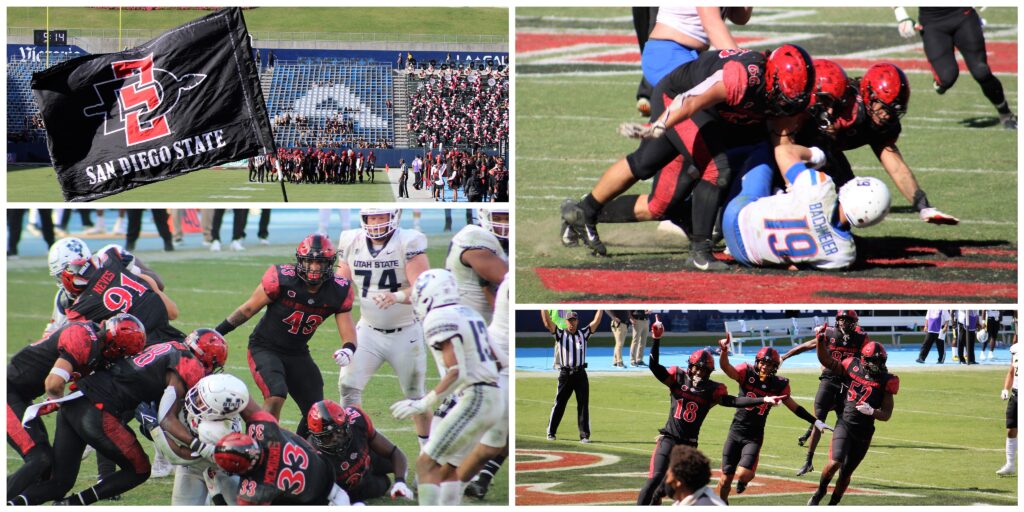
Credit: Garrison/EVT
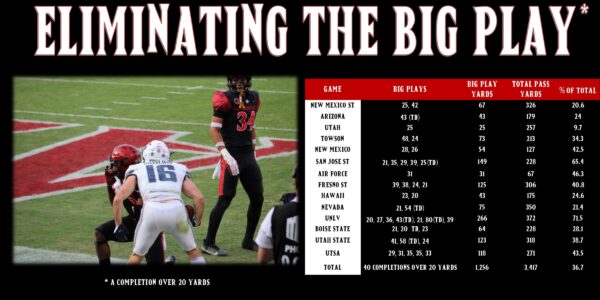
What is the SDSU football school record most likely to stand forever?
Ryan Lindley’s career passing mark of 12,690 yards, Rashaad Penny’s 2,974 single-season all-purpose yards record, Marshall Faulk’s single-game touchdown mark of seven, and Donnel Pumphrey’s career rushing yards of 6,405 will be very difficult to top. The single most challenging record, however, belongs to the 1937 defense that allowed 2.0 points a game. In a 7-1 season, they won six of their games via shutout. Their only loss was a 10-9 barn burner against the University of Redlands.
Other teams have made a run at that mark, most notably the teams with John Madden as their defensive coordinator. The team record in the Division One era is 11.2, set by the 1970 Aztecs. Since 1978, SDSU has allowed fewer than 20 points a game in only six seasons. Five of those have come in the last eight years, including this past season. The lone outlier was the 2003 squad, which gave up 17.3 points a contest.
With every linebacker and defensive linemen returning from a 2020 squad that surrendered only 17.8 points a game, one of the storylines heading into the season was wondering how historical the 2021 defense could be. In the final analysis, this group missed on being a defense for the ages because of one glaring weakness.
[wpedon id=”49075″ align=”right”]
“The best play for the offense, as is often the case for opposing teams when they face the Aztecs, was the jump ball pass to the outside.” As it turned out, this sentence written following the team’s first scrimmage alluded to a lingering issue in SDSU’s otherwise impenetrable defense. As the graphic above indicates, 36.7% of the passing yards given up occurred on just 40 passing plays.
In fairness, this issue was not unique to the 2021 squad. Since 2013 there have only been nine games where SDSU did not give up a pass of 20 yards or more, and four of those games came against triple-option teams. The 3-3-5 is a risk/reward defense. The risk is big plays for the offense, especially in the passing game, in order to reap the rewards of game-changing turnovers on defense.
Still, imagine how dominant this defense would have been if it had been more competitive in half of those 40 big plays. The Aztecs gave up 32 touchdowns in 2021, seven on the ground and 25 through the air. On the season, the defense surrendered 19.79 points a contest. It would have been drastically reduced if it had been better at denying receptions on 50/50 balls.
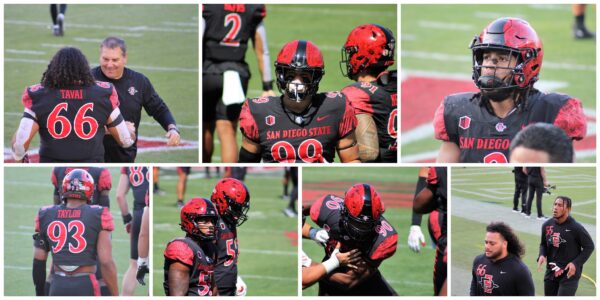
Defensive Line: A+
Player Tackles TFL Sacks BU QBH FR FF
Cameron Thomas 71.0 20.5 11.5 0 19 0 1
Jonah Tavai 47.0 14.0 8.5 0 11 0 0
Keshawn Banks 35.0 11.0 5.0 2 13 0 0
Jalil Lecky 12.0 1.5 1.5 0 3 0 0
Kahi Neves 12.0 1.0 1.0 0 0 1 0
Sefo Mailangi 9.0 4.5 1.5 0 3 0 0
One of the differences between Kurt Mattix’s and Rocky Long’s defenses is the number of players who get involved in the pass rush. In the final four years of Long’s tenure, an average of 13 players registered at least half a sack. Over the past two seasons, that number has fallen to 9.5. It remains to be seen if this is due to Mattix’s personality as a play-caller or simply the defensive coordinator building his defense according to the strengths of his personnel.
In 2021, SDSU’s 41 sacks were tied for 11th most in the country. They finished one off the school record of 42 set in 1991. The defensive line accounted for 29 of the Aztecs’ QB takedowns. As a percentage of the team’s sacks, the line this season was far and away better than any in the past six seasons. This group’s 70.7% mark beat the 2020 (65%), 2019 (59.7%), 2018 (36%), 2017 (50%), and 2016 (62.1%) teams. It is the clearest indication of how dominant this group became as they played more snaps. Cameron Thomas finished first on the team with 11.5 sacks, Jonah Tavai was second with 8.5, and Keshawn Banks was third with 5.0. The trio also had 43 QB hurries, which is defined as a quarterback pressure that leads to an incomplete pass.
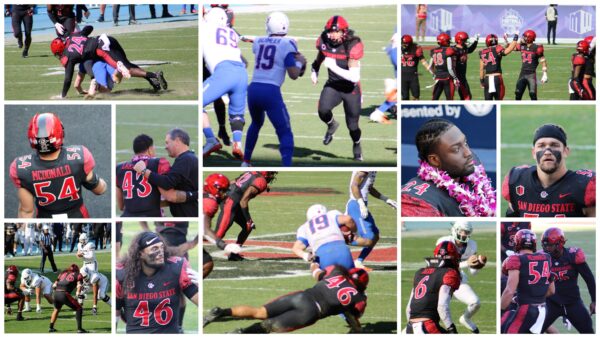
Linebacker: A
Player Tackles TFL Sacks INT BU QBH FR FF
Michael Shawcroft 55.0 6.5 3.0 1 1 4 0 2
Segun Olubi 53.0 3.5 2.0 0 1 10 0 2
Caden McDonald 49.0 6.5 3.0 0 2 4 0 0
Andrew Aleki 44.0 2.0 1.0 2 0 6 0 0
Seyddrick Lakalaka 44.0 4.5 0 1 0 1 0 0
Fountain, Garret 19.0 6.0 3.0 0 1 1 1 0
Living up to their high expectations, the LBs on the team were terrific. As a group, they totaled 12 sacks. It is tied for the most sacks among the team’s linebackers since at least 2016. The 2018 group also had 12 led by Kyahva Tezino’s 8.5. This year, the group was remarkably balanced. Caden McDonald, Michael Shawcroft, and Garret Fountain had three sacks apiece. Segun Olubi chipped in with two, and Andrew Aleki had one.
The group was also close in tackles. Shawcroft (55), Olubi (53), McDonald (49), Aleki (44), and Lakalaka (44) fourth, five, sixth, and tied for eighth respectively in tackles. Add 26 QB hurries, and it shows how well the linebackers played.
One final note worth mentioning. Aleki’s two touchdowns this season, both on interception returns, place him tied for eighth on the team in points scored. He was tied with two offensive stalwarts, Daniel Bellinger and Kaegun Williams.
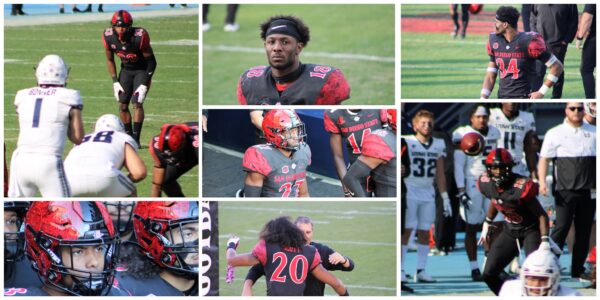
Safety: B+
Player Tackles TFL Sacks INT BU QBH FR FF
Patrick McMorris 90.0 2.5 0 4 9 0 1 0
Thompson, Trenton 41.0 3.5 0 2 14 2 0 1
Barfield, Cedarious 39.0 2.0 0 0 3 1 0 0
Baskerville, CJ 39.0 1.0 0 1 3 0 1 0
As sensational as Cameron Thomas was this season, an argument could be made that Patrick McMorris was the MVP of the defense. Playing the team’s namesake position, he led SDSU with 90 tackles and four interceptions. He was also third on the team with nine pass breakups. As importantly, he cleaned up a lot of plays that were designed to put pressure on SDSU’s inexperienced corners. McMorris was sensational and played his way onto the NFL radar.
On the other hand, McMorris may not have even been the best player among the safeties. Trenton Thompson was McMorris’ secondary mate not only with the Aztecs but also on the All-MW First Team. The primary nickel back for the team, Thompson led SDSU with 14 passes defended and was tied for second with two interceptions. Playing nearly as isolated as a corner, he nonetheless chipped in with 41 tackles.
Playing the third wheel to McMorris and Thompson were two players short on experience but long on talent. Cedarious Barfield started the season at the second Warrior safety and showed well throughout with 39 tackles and three pass breakups. When Barfield went down with an injury, true freshman CJ Baskerville stepped in. In Barfield’s absence, Baskerville took home Defensive MVP honors in the Frisco Bowl. With McMorris, Barfield, and Baskerville returning next season, the position looks solid moving into 2022.
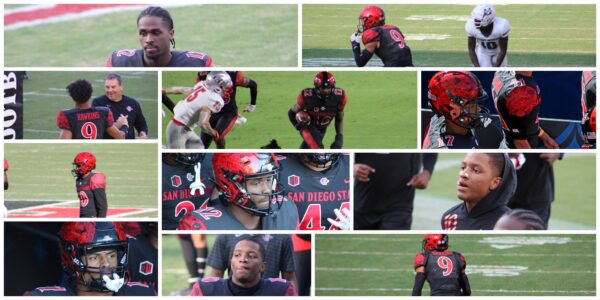
Cornerback: B-
Player Tackles TFL Sacks INT BU QBH FR FF
Hawkins, Tayler 62.0 1.0 0 2 11 1 0 1
Tumblin, Noah 32.0 0 0 0 7 0 0 0
Branch, Dallas 20.0 2.0 0 2 5 0 1 1
Avinger, Noah 15.0 0.5 0 1 2 0 1 0
Noah Avinger was recruited by a glutton of Power Five school. Like Damontae Kazee and Darren Hall before him, he rejected multiple Pac-12 offers to come to the Mesa. The reason SDSU attracts top talent like Avinger, Hall, and Kazee is because of the way corners are built. The Aztecs put their corners on islands. Top corners want the team’s success or failure on their shoulders.
The 2021 corners prevented the defense from being historic, but they were still very good on the year. They were a lot better than SDSU’s 92nd ranked pass defense suggests. Only one team faced more passing attempts than the Aztecs. SDSU opponents threw 524 times because they basically gave up running the ball against the nation’s second-best rush defense. The team ranked 21st in yards per completion in the country, giving up only 11.02 yards a reception and 11th overall in yards per attempt.
Despite facing a barrage of passes each week, the Aztecs gave up only 244.1 yards a game due in large part to the play of their corners. Opposing teams used bubble screens and short passes in lieu of running the football. The corners, especially Taylor Hawkins, responded very well. Hawkins often lined up on the short side of the field completely isolated and was rarely beaten all year. The trio of Dallas Branch, Noah Tumblin, and Noah Avinger emerged as a solid group with lots of potential for the future.
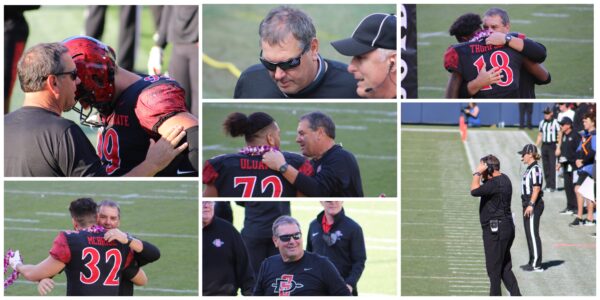
Coaching: A
The Mountain West Coach of the Year was terrific this year. An old-school coach who would rather respect the opposition than run up the score, Hoke has found a perfect place at SDSU to keep the best of how sports used to be played alive. The Aztecs have an authentic family atmosphere in a day and age where building that type of culture is an artificial technique. Competition among the players is high, but so is their camaraderie and “brotherhood.”
On the field, Hoke’s team played with an iron will, somehow finding ways to grind out a dozen victories. As football has gone soft, SDSU has grown into one of the most physical teams in the country. Beat up is how Utah’s coach Kyle Whittingham described his team after playing against the Aztecs. Thomas described it best before the Frisco Bowl, “I think we are the toughest program in the nation.”
Hoke missed out on the A+ because of some odd game management choices throughout the season. His instincts were off too often when he allowed Matt Araiza to go 3-for-9 from kicks deeper than 50 yards.
SDSU was great in the third quarter, not because Hoke and his staff made adjustments. They excelled after the intermission because, at halftime, the message was always the same, “Play like Aztecs.”
My earliest sport’s memory involve tailgating at the Murph, running down the circular exit ramps, and seeing the Padres, Chargers and Aztecs play. As a second generation Aztec, I am passionate about all things SDSU. Other interests include raising my four children, being a great husband and teaching high school.